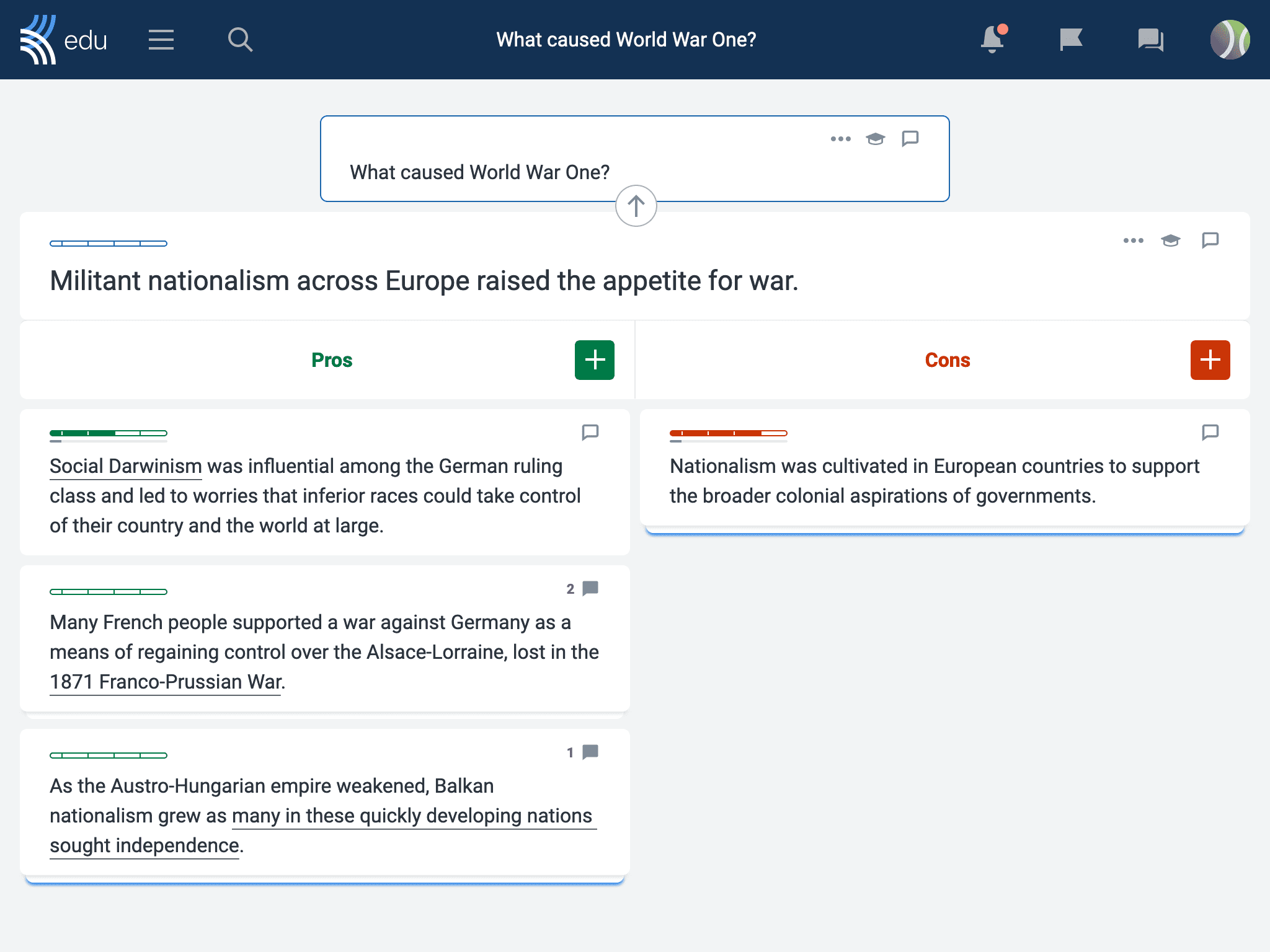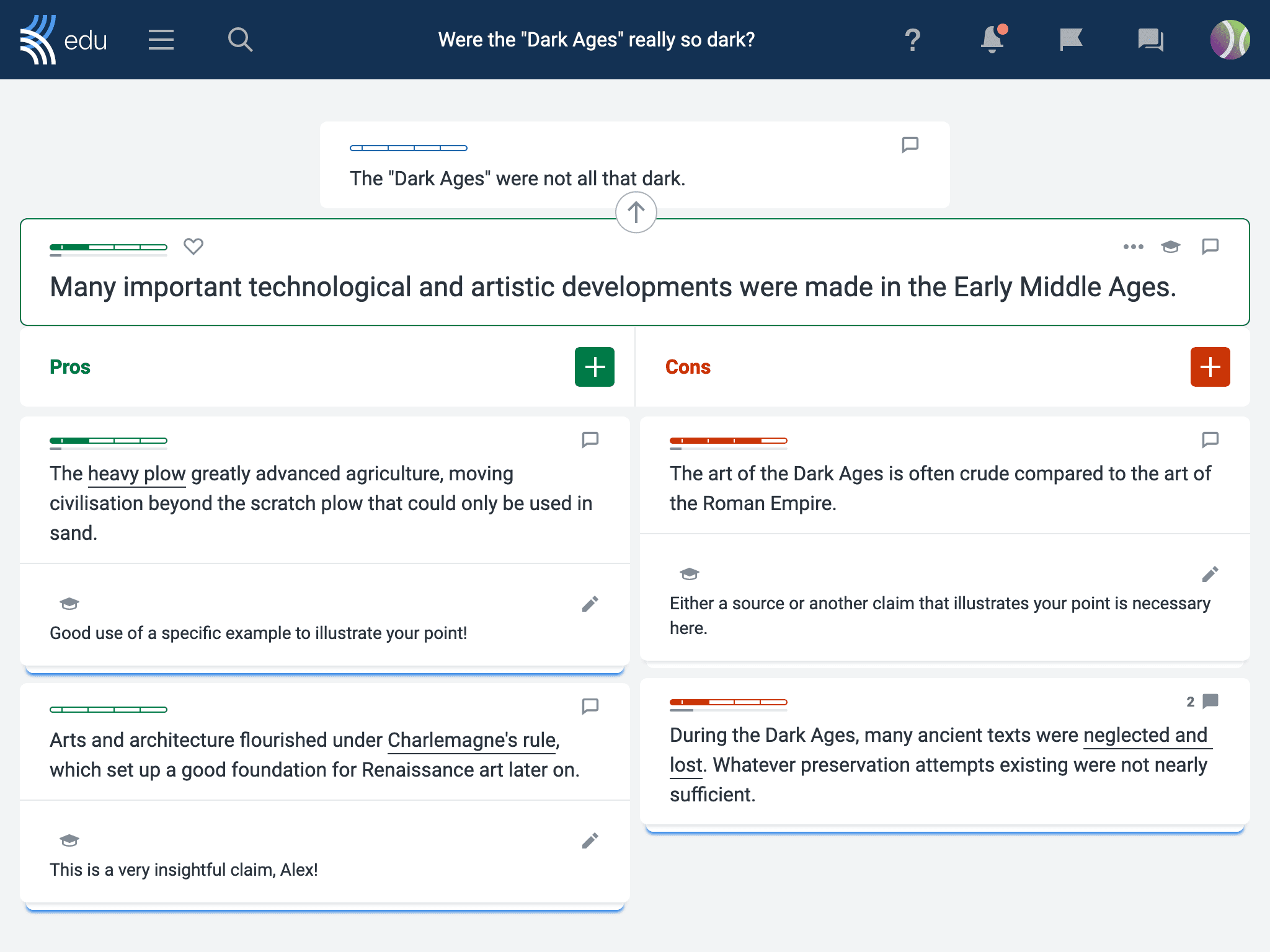Over the centuries, education has been shaped by a plethora of pedagogical strategies, taking cues from the philosophies of influential thinkers ranging from Confucius, Epicurus, Lucretius, Spinoza, and Socrates to Piaget and Dewey. Among these strategies, argument mapping stands out for its potential to foster deep, critical learning.
Kialo Edu, an argument mapping platform, is a testament to the potential of this approach. Far from being a passing fad, the incorporation of Kialo Edu in education has been years in the making, and is gaining recognition for its significant potential to enhance student learning.
Kialo Edu works as a pedagogical framework, sharing several core components of effective pedagogical frameworks:
- A central question that sparks curiosity and triggers an investigation.
- An invitation for learners to lead the inquiry and construct their understanding.
- An emphasis on authenticity and connecting learning to real-world contexts.
- An emphasis on student voice and choice in shaping the argument and presenting their understanding.
- A need for individual initiative and group collaboration, both crucial in navigating through an argument map.
- Self-reflection and ongoing peer feedback to improve the map and argumentation skills.
- A public presentation or defense of the final argument map, symbolizing the culmination of the learning journey.
How Kialo Edu works as a pedagogical framework
Kialo is not strictly an instructional strategy, nor is it a formal learning theory. Instead, it belongs to the broader arena of constructivism. It is fundamentally a pedagogical framework because it offers a unique way of structuring lessons, of promoting active learning and encouraging students to construct their own knowledge.
It does this through the process of engaging with the thoughts, ideas, and claims of others, assessing the merits of these assertions, and building their own positions through logical reasoning and evidence-based arguments. There is emerging research that validates how the authentic implementation of the Kialo framework can lead to substantial improvements in academic achievement.
Indeed, this is similar to the approach taken in project-based learning or design thinking but with a sharper focus on debate and the process of forming arguments.
How educators can use Kialo Edu as an instructional framework
Adopting Kialo as an instructional framework requires a paradigm shift in the educator’s role, transitioning from the director of learning to the facilitator. This allows learners to be the main drivers of their learning, allowing them to explore content via argument mapping rather than receiving knowledge passively.
1. Using Kialo Edu to address curriculum standards

To address standards, a lesson using the Kialo framework would begin by aligning the central question and related activities with specific learning objectives. In the case of “The Causes of World War I,” the lesson might be designed to meet standards related to understanding key events, individuals, and processes of the period, analyzing primary and secondary sources, and presenting arguments supported by evidence.
Furthermore, you can use Kialo Edu to boost students’ reading skills. Reading skills would be naturally integrated into the lesson as students research the causes of World War I. For younger learners, mini-lessons on relevant reading strategies such as identifying main ideas, finding supporting details, or summarizing information might be incorporated into the lesson. For older students, the focus might be on more advanced skills like evaluating sources or recognizing bias.
2. Using Kialo Edu for assessments

Assessments in a Kialo-centered lesson could take a variety of forms. Formative assessments might include informal checks of students’ argument maps, and providing feedback on their claims, evidence, and counterarguments. Summative assessments could involve students presenting their maps and defending their conclusions to the class, or writing an essay based on their findings. These assessments would measure not only students’ understanding of the content but also their ability to think critically and communicate effectively.
3. Using Kialo Edu for student engagement
Engagement strategies in a Kialo lesson could be multifaceted. The inherent interactivity of building an argument map encourages student engagement, as students actively participate in constructing and deconstructing arguments. Opportunities for choice — in which causes to research, which claims to add or challenge, and how to present their findings — would also increase student ownership and engagement. Furthermore, the social aspect of debating and discussing ideas with peers promotes a high level of engagement.
In this way, the Kialo pedagogical framework seamlessly integrates standards, reading skills, assessments, and engagement strategies into a cohesive, student-centered learning experience. In an era characterized by rapid technological innovation, digitization, and the advent of artificial intelligence, Kialo Edu serves as a cutting-edge platform that nurtures essential 21st-century skills.
While seemingly just an ed-tech tool, Kialo Edu proves its potential as an impactful pedagogical framework. Its emphasis on inquiry, debate, and deep exploration makes it an exciting and revolutionary approach to education, nurturing learners equipped for the complexities of the 21st century.
Looking for more inspiration on how to teach critical thinking in your classroom? We’ve got lots of other resources!


